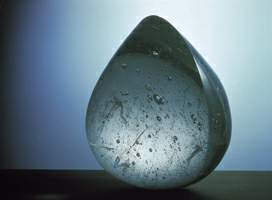Katarína Bajcurová
Exhibition in Bratislava, July – September 2003 The exhibition was dedicated to the founder of the Slovak glass school, the well-known glass artist Václav Cigler and his students. It was a return to the principles of thinking which were established, motivated and enhanced by Cigler’s school in Slovakia. Some of his students, who are significant Slovak art personalities not only in the field of glass creation but also in the field of conceptual, analytical and in action art, were able to shift and transform the ideas of their teacher in many directions and by many methods. His most famous students are M. Mudroch, V. Kordoš, A. Daučíková, Š. Pala, Z. Palová, Artprospekt P.O.P., J. Opršal, J. Gavula, A. Žáčko, J. Tomečko and others. Václav Cigler came to Bratislava from Prague with a European, open mind which had been enriched by his deep knowledge and experience of contemporary art on the wider international scene. For many, his studio has become a real intellectual workshop, a “school of thinking”, a “laboratory” or “experimental workshop”. Cigler’s specialty at the Bratislava academy was given the name “glass in architecture” to distinguish it from the Prague studio. Cigler worked with a material whose “IQ” was believed to be infinite – glass. He integrated a new phenomenon of virtual space and movement into his work, he added new elements of conceptual and land-art thinking. In his projects he manages independently to anticipate principles and ideas which found fulfilment in latter generous land projects of several western arts. He was conceptually sui generis towards glass: objects, architecture as wells as spatial and light installations were ideally projected: he counted on resulting optical and kinetic effect of the work beforehand. Similarly, untraditionally, he understood the work of jewels intended for the landscape of a body. In front of his students, he established the ethical imperative of a persistent search for the quest of his own route. Cigler’s studio has become a creative “workshop” in the right sense of the word – discussions were held about tasks, together they polished the tasks and crystallized the individual topics. Cigler’s opinion was that art could not be learnt; it could, however, be got to known, talked about, advised or criticised. Cigler’s teamwork not only taught to formulate and listen to the opinions of other but also led to consideration in context and connections. The basis was work on two platforms: utilitarian and free tasks. These were mainly “monumental and decorative” works for architecture and drinking sets intended for mass production. The social, political and cultural situation changed radically in Czechoslovakia at the beginning of 1970s. Any type of abstract quest in his free work could only take place in the “pilgrim” shelter of a studio. Some creators who were not allowed to exhibit left their works and instead concentrated the basis of their abstract programme in the public urban and architectonic environment with which they could influence minds and form aesthetic feelings in the citizens. Ideology was not required in utilitarian work: its task was to depict functions of the environment materially, and from time to time experiment was tolerated. Therefore, “utilitarian” artists were able to survive the normalization, even though not easily but, nevertheless, not by cutting their programme. This was one of the reasons Cigler’s department was able to work relatively independently, even though it must be mentioned that personal hatred together with the political and ideological pressure from the university’s directorate gradually worsened. Therefore, at the end of 1970s, Cigler was no longer willing to undergo all this and, “voluntarily under pressure” left the school to return to Prague.
